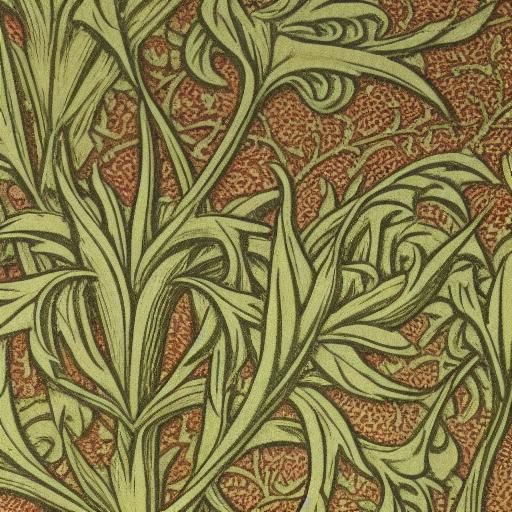Meaning of Acanthus and its using in Art Nouveau
Acanthus is a plant native to the Mediterranean region, known for its distinctive and elaborate foliage. In Art Nouveau, the acanthus motif holds significant meaning and is commonly used in various forms of artistic expression. The use of acanthus in Art Nouveau can be attributed to both historical references and aesthetic considerations.
Historically, the acanthus motif can be traced back to ancient Greek and Roman architecture. It was prominently used as a decorative element in the capitals of Corinthian columns, symbolizing prosperity, abundance, and endurance. The intricate and stylized leaves of the acanthus plant became a symbol of classical beauty and architectural refinement. Art Nouveau drew inspiration from the rich history of ornamentation and incorporated the acanthus motif as a way to connect with the past while infusing it with a fresh, modern interpretation.
In Art Nouveau, the acanthus motif represents natural forms and the organic world. It captures the movement’s desire to incorporate elements of nature into art and design, rejecting the rigid and artificial aesthetics of industrialization. The sinuous and flowing nature of acanthus leaves aligns with the curvilinear and organic lines prevalent in Art Nouveau creations, creating a harmonious visual language.
The acanthus motif also holds symbolic meaning within the context of Art Nouveau. The plant’s association with abundance and fertility represents the ideals of growth, renewal, and vitality. By incorporating acanthus leaves into their works, Art Nouveau artists aimed to evoke a sense of natural beauty, prosperity, and the interconnectedness of humanity with the natural world.
Furthermore, the intricate and detailed nature of acanthus leaves lends itself well to the decorative and ornamental qualities of Art Nouveau. The graceful curves, deeply cut veins, and delicate interplay of light and shadow within the foliage provide ample opportunities for artistic expression and intricate embellishment. Acanthus leaves can be found adorning various Art Nouveau creations, such as architectural elements, furniture, jewelry, and illustrations, adding a sense of elegance, richness, and complexity to the overall design.
Presenting texture with lines
In Art Nouveau works, lines play a crucial role in depicting the texture and details of leaves. The intricate and flowing lines used to render the leaves capture the organic and natural essence of the plant world, contributing to the overall aesthetic of the artwork.
Art Nouveau artists often employed sinuous and curvilinear lines to portray the texture of leaves in a visually appealing and dynamic manner. These lines follow the contours of the leaves, mimicking the natural growth and movement of foliage. They may be bold and sweeping or delicate and intricate, depending on the desired effect and the specific leaf being depicted.
The use of lines allows the artist to convey the surface characteristics of leaves, such as their veins, ridges, and patterns. The lines can be used to represent the delicate network of veins that provide structure and transport nutrients within the leaf. They may also depict the serrated edges or irregular shapes that are unique to different types of leaves. Through the skillful manipulation of lines, the artist captures the intricacy and variety found in nature, adding depth, realism, and visual interest to the depiction of leaves.
Moreover, lines in Art Nouveau are not limited to mere representation but also serve an expressive purpose. They add a sense of movement, rhythm, and energy to the artwork, reflecting the dynamic and flowing forms prevalent in the Art Nouveau style. The continuous and uninterrupted lines create a sense of unity and harmony within the composition, guiding the viewer’s eye and enhancing the overall visual appeal.
Create Art Nouveau pattern with AI Prompt
In the realm of visual art, AI image generation has opened up a world of creative possibilities, allowing us to transform prompts into captivating and intricate artworks. Let us delve into the prompt “a close-up of a pattern of plants, a mid-nineteenth-century engraving by William Morris, arts and crafts movement, acanthus, acanthus scrolls, art nouveau, sharp colors” and explore the elements that will shape the resulting image.
The prompt invites us to envision a close-up view of a pattern featuring plants. This central motif captures the essence of nature’s beauty, emphasizing the intricate details and organic forms of various plant species. The image will showcase the richness and diversity of plant life, immersing viewers in a tapestry of natural wonder.
Inspired by the mid-nineteenth-century engravings by William Morris, a prominent figure in the arts and crafts movement, the artwork will embrace the movement’s principles of craftsmanship, attention to detail, and celebration of nature. The influence of Morris will be reflected in the meticulous rendering of the plants, showcasing a harmonious blend of botanical accuracy and artistic interpretation.
Central to the prompt is the mention of acanthus and acanthus scrolls, which are iconic elements of art nouveau. These ornamental motifs, characterized by their elegant, flowing lines, will adorn the pattern, infusing it with a sense of timeless beauty and sophistication. The inclusion of acanthus scrolls adds a touch of refinement and intricate craftsmanship, enhancing the overall aesthetic appeal of the artwork.
Sharp colors play a vital role in bringing the pattern to life. The prompt calls for the use of vivid and bold color palettes, which will heighten the visual impact and create a sense of vibrancy and dynamism within the composition. These sharp colors will not only accentuate the intricate details of the plants and scrolls but also evoke a sense of energy and vitality.
By harnessing the capabilities of AI image generators such as Stable Diffusion and Midjourney, we can transform this prompt into a captivating artwork that embodies the essence of the arts and crafts movement, art nouveau, acanthus motifs, and vibrant color schemes. We can also use it in design tool like Visual Paradigm Online as elements for further adjustment and customization. Enjoy your creation now!


